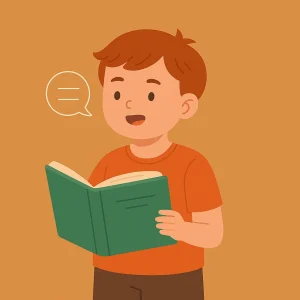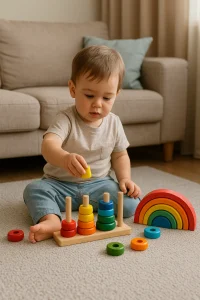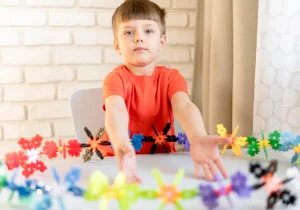Fun 7 Activities to Boost Emotional Regulation in Young Children
By Wellness Hub
Last Updated: September 9, 2024
Emotional regulation is a crucial skill for young children, as it lays the foundation for healthy social interactions, better behavior, and overall emotional well-being. Imagine your child learning how to handle frustration when a toy doesn’t work or calmly expressing excitement instead of overwhelming energy. These are all part of emotional regulation, and when children develop these skills early on, they’re better equipped to navigate life’s ups and downs.
But here’s the best part: teaching kids emotional regulation doesn’t have to be a tedious task. In fact, it can be a lot of fun! Engaging activities that children enjoy can make learning these skills feel less like a chore and more like playtime. Whether it’s through games, storytelling, or creative exercises, these fun activities can help children understand and manage their emotions in a natural, enjoyable way.
Understanding Emotional Regulation in Young Children
Emotional regulation is the ability to recognize, understand, and manage one’s emotions in various situations. For young children, this means learning how to express feelings like happiness, anger, sadness, or frustration in appropriate ways. Emotional regulation is essential because it helps children develop resilience, form positive relationships, and navigate social settings with greater ease. Imagine your child calmly waiting for their turn on the playground or being able to talk about what made them upset instead of having a meltdown. These are just a few examples of how emotional regulation plays a vital role in daily life.
However, managing emotions isn’t always easy for children, and that’s perfectly normal. Common challenges include difficulty in identifying what they are feeling, reacting impulsively to strong emotions, and struggling to calm down when upset. You might notice this when a child gets easily frustrated with a challenging task or becomes overly excited and finds it hard to settle down. These hurdles can make it tough for them to interact with others or cope with everyday challenges.
As parents and caregivers, your role in supporting your child’s emotional regulation is incredibly important. Children learn a great deal by observing how adults handle their own emotions. By modeling calmness and showing healthy ways to express feelings, you provide a powerful example for them to follow. Additionally, being patient and validating their emotions—letting them know it’s okay to feel sad, angry, or scared—helps them understand that all feelings are valid and manageable.
Also read: Emotional Regulation for Kids: Easy Tips and Activities
Top Fun Activities to Enhance Emotional Regulation
Helping young children learn to manage their emotions can be a fun and interactive experience. Here are some engaging activities that not only teach emotional regulation but also provide a joyful learning journey for your child. These activities can be easily integrated into your daily routine, making emotional growth a natural part of playtime.
1. Emotion Charades
Emotion Charades is a playful twist on the classic charades game but with a focus on emotions. To play, write down different emotions on slips of paper, such as happy, sad, angry, surprised, or scared. Take turns acting out each emotion without using words while the others guess which emotion is being portrayed. This game helps children recognize and express various emotions through body language and facial expressions.
Benefits: This activity increases emotional awareness and expression skills. It’s an excellent way for children to understand that all emotions are valid and learn how to communicate them effectively.
2. Calm-Down Jars
Calm-down jars are simple to make and can serve as a great tool for self-soothing. To create one, fill a clear jar with water, add glitter glue and extra glitter, and seal it tightly. When your child feels overwhelmed, they can shake the jar and watch the glitter settle as they take deep breaths. The swirling glitter gives them something calming to focus on, helping them to relax and reset their emotions.
Benefits: Calm-down jars teach children to take a moment to pause and breathe, helping them to regulate their emotions and find their calm in stressful moments.
3. Feelings Matching Game
Create a matching game using cards that depict various emotions and corresponding scenarios. For example, one card might show a picture of a child crying, while the matching card describes a scenario like “losing a favorite toy.” As your child matches the pairs, discuss what the emotion looks like and what might cause it.
Benefits: This game enhances emotional vocabulary and understanding, allowing children to better identify and articulate their feelings in different situations.
4. Breathing Exercises and Mindful Moments
Simple breathing exercises can work wonders in helping children calm down and manage their stress. One easy exercise is called ‘Smell the Flower, Blow Out the Candle.’ Encourage your child to pretend they are smelling a flower (inhale through the nose) and then blowing out a candle (exhale through the mouth). This simple routine can be done anywhere, whether at home or on the go.
Benefits: Breathing exercises like this help children learn how to regulate their physical responses to emotions, making it easier for them to stay calm and collected.
5. Storytelling with Emotional Themes
Reading stories with emotional themes is a great way to help children explore different feelings. Choose books where characters experience a range of emotions, and pause to discuss how the characters might be feeling and why. Ask your child questions like, “How do you think the character feels right now?” or “What would you do if you felt that way?”
Benefits: This activity improves empathy and helps children relate to others’ emotions, fostering a deeper understanding of their own and others’ feelings.
6. Role-Playing Scenarios
Role-playing allows children to practice their responses to various emotional situations in a safe and controlled environment. Set up simple scenarios, like “What would you do if someone took your toy?” and let your child act out their response. Encourage them to think of multiple ways to handle the situation.
Benefits: Role-playing prepares children for real-life emotional challenges, giving them the confidence to handle situations constructively.
7. Emotion Wheel or Chart
An emotion wheel or chart is a visual tool that helps children identify and express their feelings. Create a wheel divided into segments, each labeled with a different emotion and corresponding facial expression. When your child feels overwhelmed, guide them to point to the emotion that best matches how they feel.
Benefits: Using an emotion wheel builds self-awareness and communication skills, making it easier for children to share what they are experiencing.
Emotional Regulation Activities at a Glance
| Activity | How to Do It | Key Benefits |
|---|---|---|
| Emotion Charades | Write down different emotions on slips of paper. Take turns acting out the emotions while others guess them. | Improves emotional awareness and expression skills. |
| Calm-Down Jars | Create a jar filled with water and glitter. When shaken, the glitter settles, helping the child to relax. | Teaches children to self-soothe and take calming breaks. |
| Feelings Matching Game | Use cards with pictures of emotions and matching scenarios. Have children match the emotion to the scenario. | Enhances emotional vocabulary and understanding. |
| Breathing Exercises | Practice simple breathing techniques like ‘Smell the Flower, Blow Out the Candle’ to help calm the body. | Helps manage stress and regulate emotional responses. |
| Storytelling | Read stories with emotional themes and discuss how characters feel and respond. | Builds empathy, understanding, and emotional awareness. |
| Role-Playing Scenarios | Set up scenarios and act out how to respond to different emotional situations, like sharing or expressing anger. | Prepares children for real-life emotional challenges. |
| Emotion Wheel or Chart | Use an emotion wheel or chart with different emotions listed. Guide children to point to how they are feeling. | Improves self-awareness and communication about feelings. |
The Benefits of Improving Emotional Regulation in Young Children
Helping your child develop emotional regulation skills is one of the most valuable things you can do as a parent or caregiver. The benefits extend far beyond just keeping tantrums at bay; these skills lay a strong foundation for your child’s future success in social interactions, learning, and overall well-being.
1. Better Social Skills
Children who can regulate their emotions tend to have better social skills. When kids understand and manage their feelings, they can interact more positively with others, share, take turns, and handle conflicts calmly. This doesn’t just make playdates go smoother—it helps them build lasting friendships and become more empathetic individuals. Imagine your child confidently navigating social situations with peers, knowing how to respond when things don’t go their way. That’s the power of emotional regulation.
2. Improved Behavior
Emotional regulation directly influences a child’s behavior. By learning to manage emotions like anger, frustration, or excitement, children are less likely to act out impulsively. This leads to fewer meltdowns and more cooperative behavior, whether at home, in school, or out in public. It’s not just about reducing negative behaviors; it’s about empowering your child with the tools to make thoughtful decisions and express themselves in appropriate ways.
3. Enhanced Coping Mechanisms
Life is full of ups and downs, and building emotional resilience early on helps children handle challenges better. Kids who practice emotional regulation are equipped with coping mechanisms that help them stay calm in the face of adversity. Whether it’s a minor setback like losing a game or a bigger issue like moving to a new school, children with good emotional regulation skills can navigate these changes with greater ease and confidence. These coping skills are not just for childhood; they are lifelong assets that will serve your child well into adulthood.
Conclusion
Teaching emotional regulation is a vital part of childhood development, and the journey can be both joyful and educational. Using engaging activities like Emotion Charades and Calm-Down Jars not only makes the process fun but also ingrains crucial life skills such as coping mechanisms and social behaviors. As a parent or caregiver, your patience and consistency are key in nurturing your child’s emotional growth. Celebrate each achievement, no matter how small, and remember that each step forward contributes to building a resilient and emotionally intelligent future adult. For further guidance, Wellness Hub is always ready to support you with additional resources and tips.
Frequently Asked Questions:
1. What is emotional regulation, and why is it important for young children?
Emotional regulation is the ability to recognize, understand, and manage one’s emotions. For young children, it helps them handle their feelings in a healthy way, leading to better behavior, improved social skills, and stronger coping mechanisms in challenging situations.
2. How can I help my child learn emotional regulation?
You can help your child learn emotional regulation by incorporating fun activities into their daily routine, such as Emotion Charades, Calm-Down Jars, and breathing exercises. These activities make learning about emotions enjoyable and effective.
3. What are some fun activities to teach emotional regulation to kids?
Some fun activities include playing Emotion Charades, creating Calm-Down Jars, using Feelings Matching Games, and engaging in role-playing scenarios. These activities help children identify and express their emotions in a playful and engaging way.
4. How do Calm-Down Jars help with emotional regulation?
Calm-Down Jars are filled with water and glitter, allowing children to focus on the swirling glitter as a calming technique. This activity teaches kids to take a moment to breathe and relax, helping them reset their emotions when they feel overwhelmed.
5. What are the benefits of improving emotional regulation in young children?
Improving emotional regulation in young children leads to better social interactions, improved behavior, and enhanced coping skills. It helps them manage their feelings in a healthy way, which is essential for their overall development and well-being.
6. How can breathing exercises help my child manage stress?
Simple breathing exercises, like ‘Smell the Flower, Blow Out the Candle,’ can help your child learn to calm down and manage stress. These exercises teach kids how to control their breathing, which helps regulate their emotional responses in stressful situations.
7. Why should parents and caregivers be involved in teaching emotional regulation?
Parents and caregivers play a crucial role in teaching emotional regulation because children learn best through observation and guidance. By modeling calm behavior and supporting their emotional learning, you can help your child develop strong emotional skills.
8. How can storytelling help my child with emotional regulation?
Storytelling with emotional themes allows children to explore different emotions through characters in stories. Discussing how characters feel and why helps children better understand and relate to their own emotions, enhancing their empathy and emotional awareness.
9. Can fun activities really improve my child’s emotional regulation?
Yes, fun activities can significantly improve your child’s emotional regulation. By turning learning into play, these activities keep your child engaged and make the process of understanding and managing emotions more enjoyable and effective.
10. Where can I find more resources on emotional regulation for kids?
For more resources and expert guidance on supporting your child’s emotional development, visit Wellness Hub. We offer a variety of tools and tips to help you and your child on this important journey.
About Author:
Lasya Vooturi,
Clinical Psychologist (A) & Behavioral Therapist
Lasya holds a Professional Diploma in Clinical Psychology from Amity University, where she deepened her understanding of psychological principles from March 2023 to March 2024. With over a year of dedicated experience as a Behavioral Therapist, Lasya has honed her skills in applying effective therapy techniques tailored to individual needs. Fluent in Telugu, Hindi, and English, she is adept at connecting with a diverse range of clients, ensuring comprehensive communication and understanding. Lasya’s approach is grounded in empathy and scientific rigor, making her a trusted ally in navigating mental health challenges.
Book your Free Consultation Today
Parent/Caregiver Info:
Client’s Details:
* Error Message








